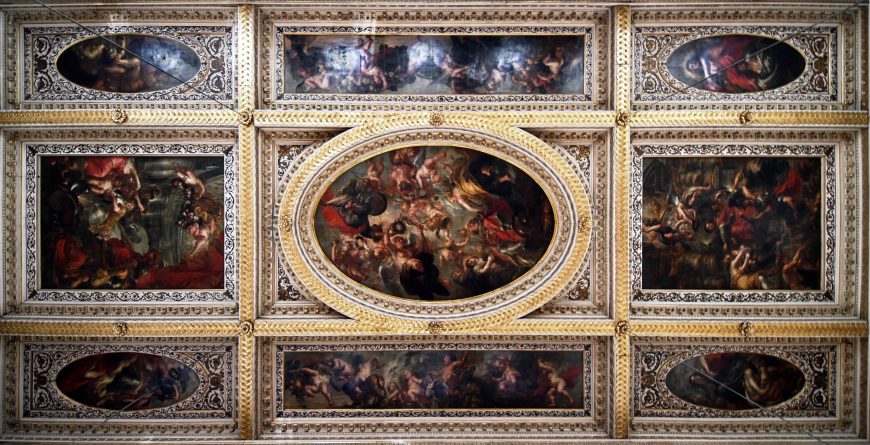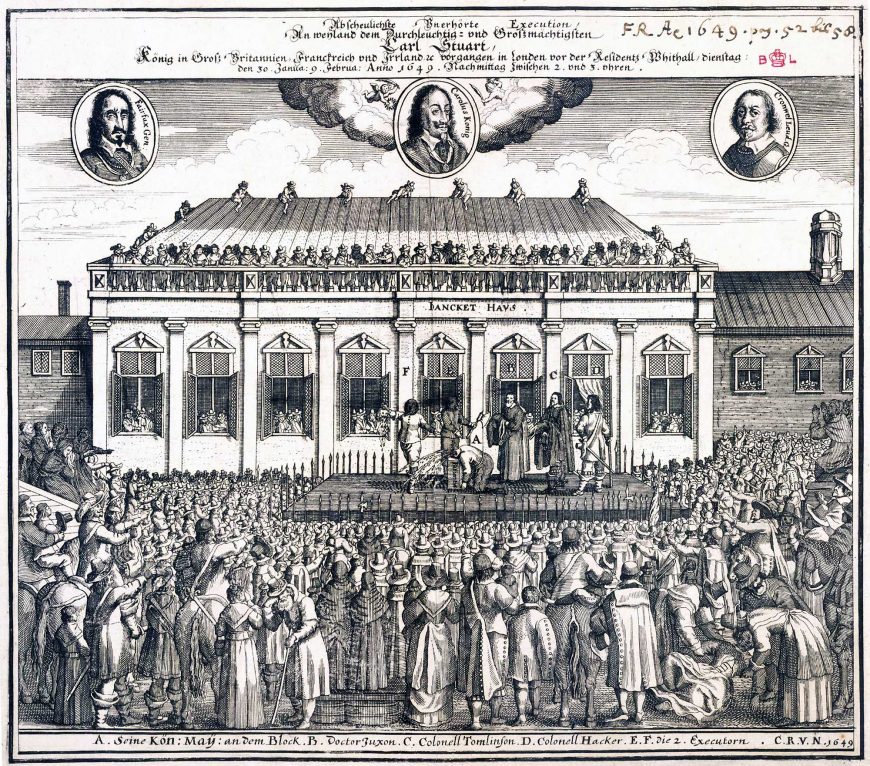
Broadside depicting the execution of Charles I, from History of the birth, life and death of Charles Stuart, 1649 (British Library)
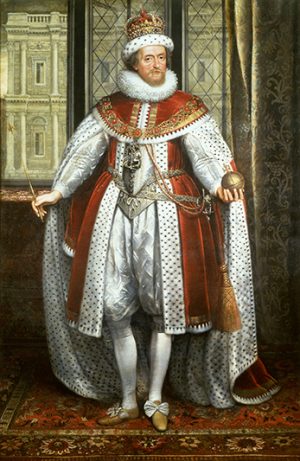
Paul van Somer, James I/VI (with the unfinished Banqueting House in the background), c. 1620, oil on canvas, 227 x 149.5 cm (The Royal Collection, London)
On January 30th, 1649, King Charles I was beheaded on a scaffold in front of the Banqueting House of Whitehall Palace in London for raising taxes without due authority and waging wars against his own people. It was an ironic backdrop for his death, as the Banqueting House was created to glorify his reign and that of his father, King James I of England. Designed by the architect Inigo Jones and decorated with paintings by the Baroque painter Peter Paul Rubens, this building symbolized the newly vibrant, lavish, and European-influenced court culture that the two monarchs fostered.
A new era for Shakespearean England
James VI of Scotland assumed the English throne upon the death of Queen Elizabeth I in 1603, becoming James I and ushering in what is known as the Jacobean era. Upon his accession, the Britain of multiple kingdoms (England, Wales, Scotland, and Ireland), was born.
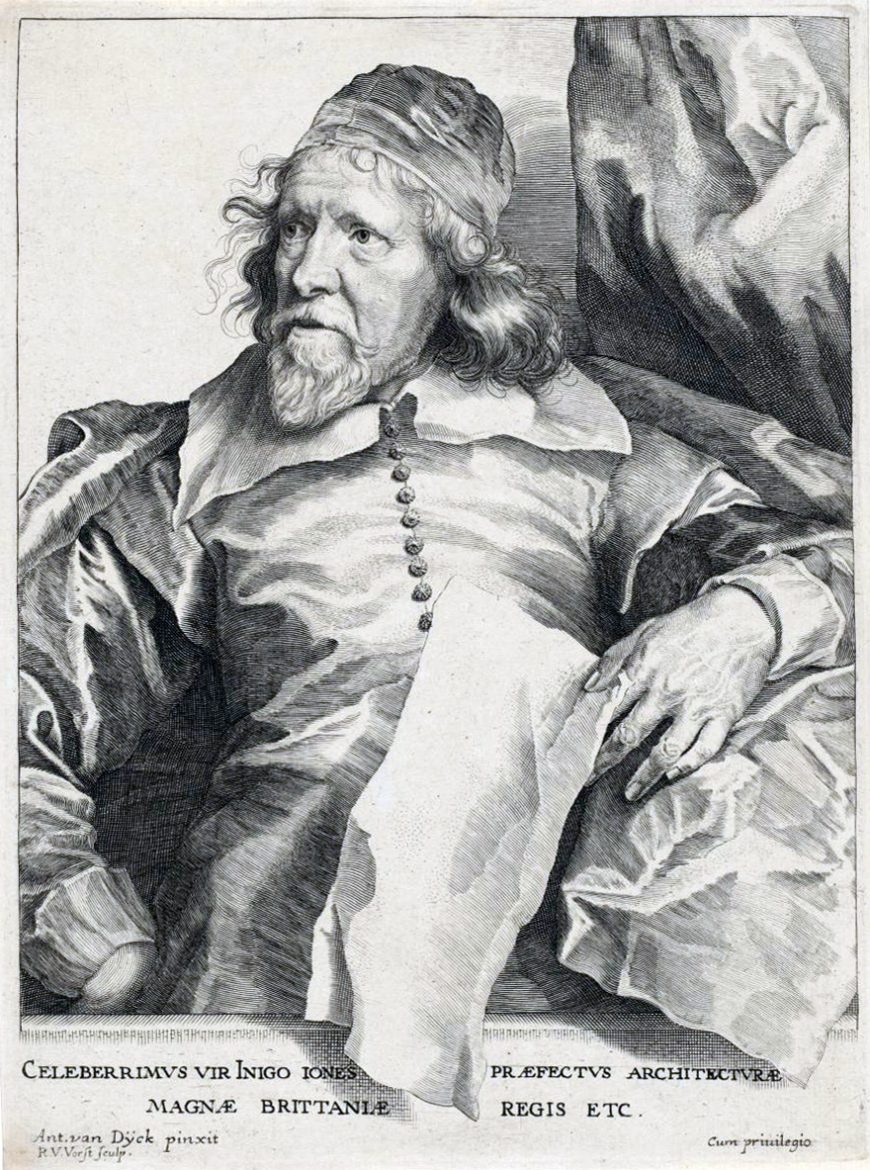
Robert van Voerst, Portrait of Inigo Jones, after Anthony van Dyck, from Icones Principum Virorum, before 1636, 24.5 x 17.5 cm (The British Museum)
James I was widely criticized by his contemporaries, not only for his near-catastrophic financial mismanagement, but also for his publicly embarrassing over-indulgences. However, despite these shortcomings, James was a monarch with a great interest in the arts and a serious scholarly mind: his reign witnessed the production of some of William Shakespeare’s most brooding tales of kingship, such as Macbeth and King Lear, as well as the publication of the King James Bible. James himself also published many works, including treatises that set forth his views on kingship (encapsulated in the famous phrase “God’s lieutenant upon earth”—i.e. God’s direct representative). Jacobean Britain was a politically charged, intellectually stimulating age with a luxurious court culture. It was in this context that the classical architectural tradition was brought from continental Europe, under the direction of Britain’s first classical architect, Inigo Jones.
Surveyor-General of the King’s Works
Inigo Jones was the foremost architect and theatre designer of the first half of the seventeenth century. Of humble origins and largely self-taught, Jones acquired his matchless understanding of classical architecture by studying the writings of Italian renaissance architects, including Sebastiano Serlio, Andrea Palladio, and an Italian translation of the work of the ancient Roman architect Vitruvius. He also had first-hand experience of these ideas from his travels to Italy and France and conversations with Palladio’s pupil Vincenzo Scammozzi.
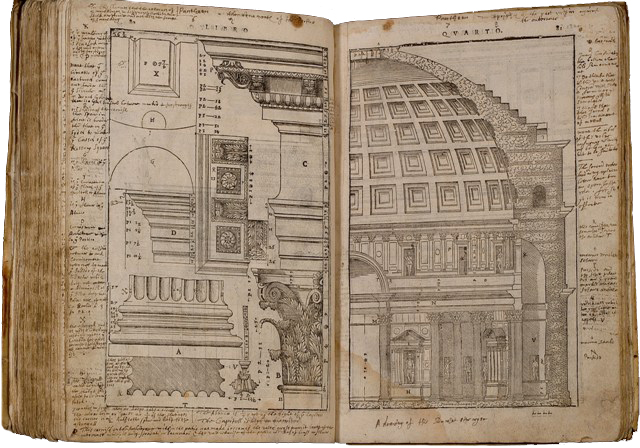
Pages from Inigo Jones’s copy of Andrea Palladio’s I Quattri libri dell’architettura, 1601, with annotations by Inigo Jones (Worcester College, Oxford)
On his return to England in 1615, Jones assumed the title of “Surveyor-General of the King’s Works,” under which he oversaw the maintenance of existing buildings and the construction of new ones. This signaled a fundamental change in the architectural landscape of London and its environs, initiated through the construction of one of Britain’s first truly classical buildings, the Banqueting House at Whitehall Palace.
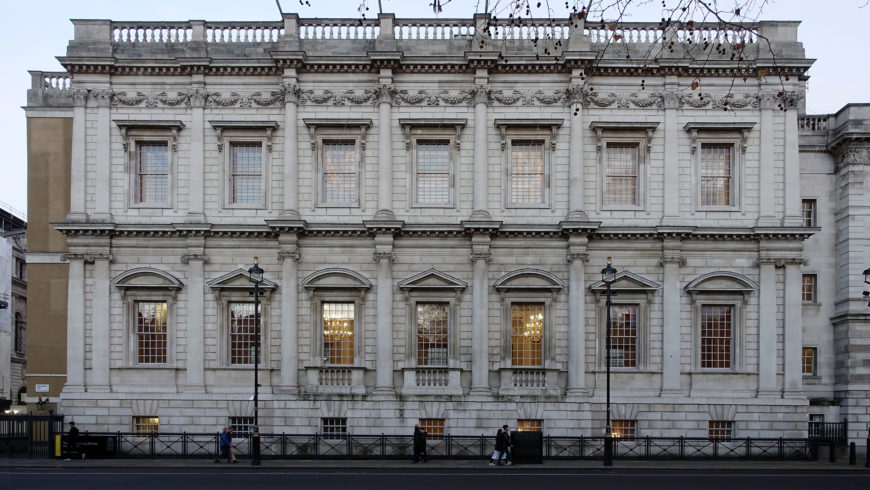
Inigo Jones, The Banqueting House, Whitehall, 1619–22 (photo: Steven Zucker, CC BY-NC-SA 2.0)
The Banqueting House
In the Jacobean era, Whitehall Palace was the principal royal residence, and the Banqueting House was regarded as the “Presence Chamber,” where the king would receive visiting ambassadors and hold ceremonies such as masques and state banquets. When the first iteration of the hall burned down in 1619, “Surveyor” Inigo Jones swiftly began work on the new building. Based loosely on a palace in Vicenza, Italy, Jones’s building testifies to his understanding of classical architecture as it had been revived in Renaissance Italy.
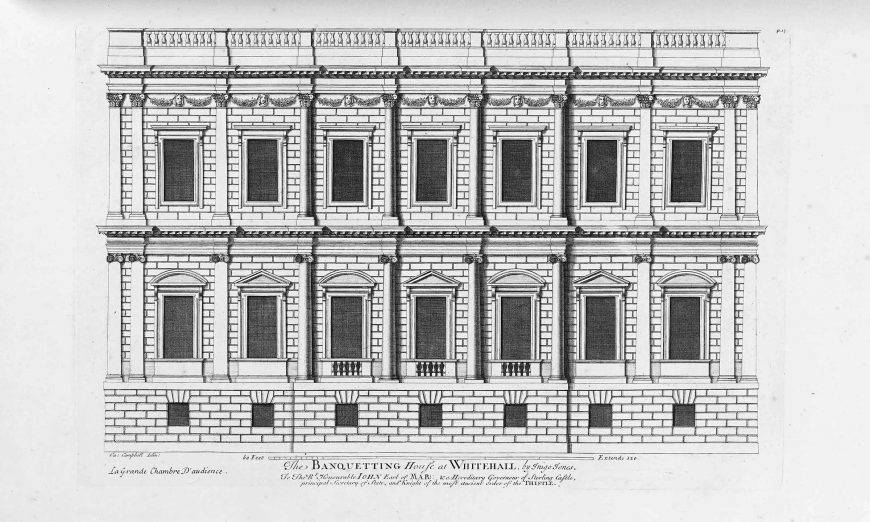
Inigo Jones, The Banqueting Hall, Whitehall, 1619–1622, from Vitruvius Britannicus, 1715, ed. Colen Campbell (Getty Research Institute)
Seven windows wide, with three central bays, the exterior is a virtuoso exercise in balance, proportion and restrained decoration. The largely rusticated front was originally a mix of Oxfordshire (honey-coloured), Northamptonshire (pinkish), and Portland (white-grey) stone, though the façade we see today was re-faced in the early nineteenth century.
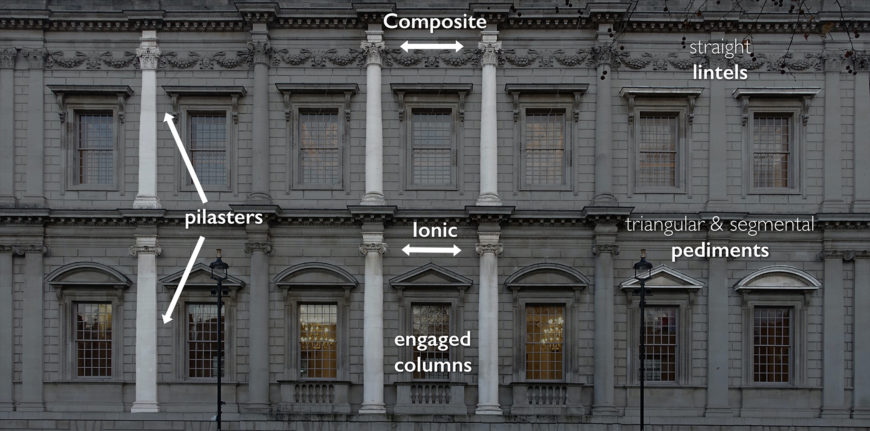
Façade architectural elements (detail), Inigo Jones, The Banqueting House, Whitehall, 1619–22 (photo: Steven Zucker, CC BY-NC-SA 2.0)
The façade is made up of two different classical orders (Ionic and Composite) on successive storeys. The three central bays are defined by engaged columns (half-embedded in the structure), with double pilasters at the ends of each storey of the façade. The windows of the lower storey are capped by alternating triangular and segmental (curved top) pediments, while there are straight lintels (horizontal beams that span openings) on the windows of the upper storey.
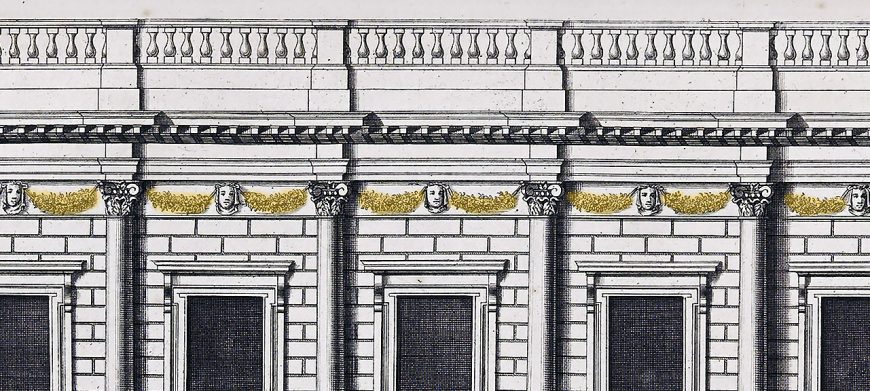
Inigo Jones, The Banqueting Hall, Whitehall (detail), 1619–22, from Vitruvius Britannicus, 1715, ed. Colen Campbell (Getty Research Institute)
The only decorative extravagance on the whole façade is a garland frieze of female masks and swags of fruit that runs across the upper storey and ties the capitals together, above which stands a balustrade (a row of decorated uprights supporting a rail).
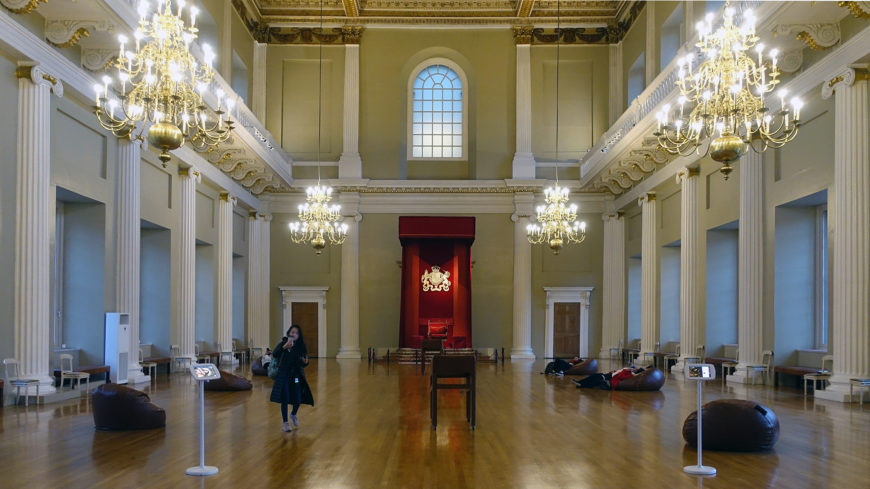
Inigo Jones, The Banqueting House, Whitehall (interior), 1619–22 (photo: Steven Zucker, CC BY-NC-SA 2.0)
Following principles set down by Palladio and Vitruvius, the interior of the Banqueting House is a single space—a double cube in volume, measuring 110 x 55 feet—and is the height of the two main storeys of the exterior façade. The interior walls parallel the exterior in their use of the classical orders, with superimposed Ionic half-columns below and Corinthian pilasters above.
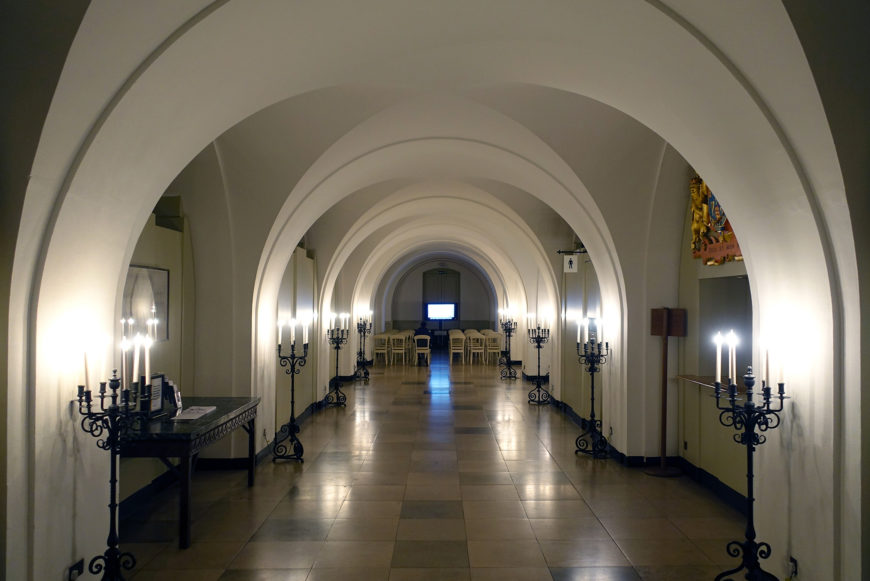
Undercroft of The Banqueting House, Whitehall Palace as it appears today (photo: Steven Zucker, CC BY-NC-SA 2.0)
Below this room is the basement or “Undercroft,” which once housed the “King’s Privy Cellar,” a rock- and shell-decorated grotto that was used as a drinking den by James and his favorites.
Paintings fit for a king
On the flat-beamed, compartmentalized ceiling are the canvases by the Flemish artist Sir Peter Paul Rubens, the only such cycle by Rubens to survive in situ (the other monumental cycle he executed being the life of Marie de’ Medici at the Palais du Luxembourg, now on display in the Louvre, Paris). James had asked Rubens to decorate the ceiling; however, it was not until the reign of James’s son, Charles I, that the commission came about. The nine canvases were produced in the artist’s Antwerp studio with the help of a team of assistants, and installed at a height of 50 feet (15.3 meters) in 1636, after which time—on the express orders of the king—no more court masques took place, in order to protect Rubens’s panels from smoke damage from lighted candles. Visitors today can view the paintings with the aid of mirrors and from the comfort of body-sized beanbags (see image above).
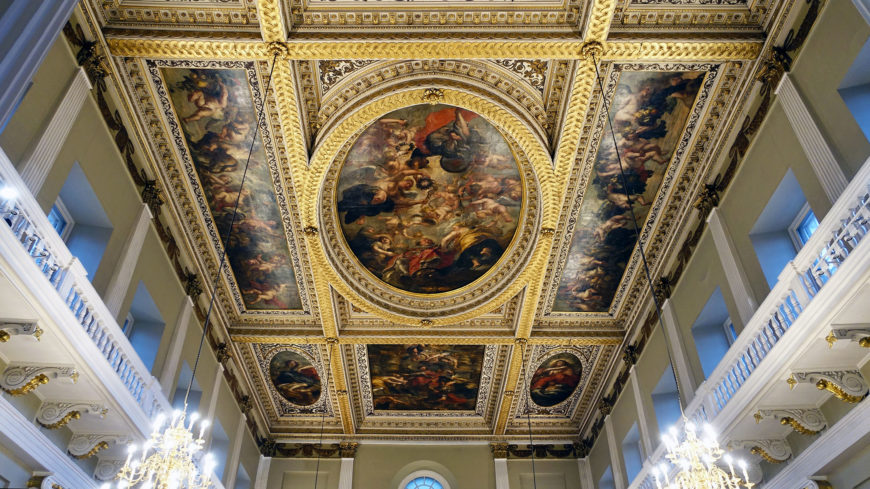
Peter Paul Rubens, ceiling of the Banqueting House, Whitehall, c. 1632–34 (photo: Steven Zucker, CC BY-NC-SA 2.0)
The canvases should be viewed as a propagandistic commemoration and celebration of the reign of Charles’s father, as well as a forceful representation of the political ideology of the divine right of kings and James’s notion of himself as “God’s lieutenant upon earth.”
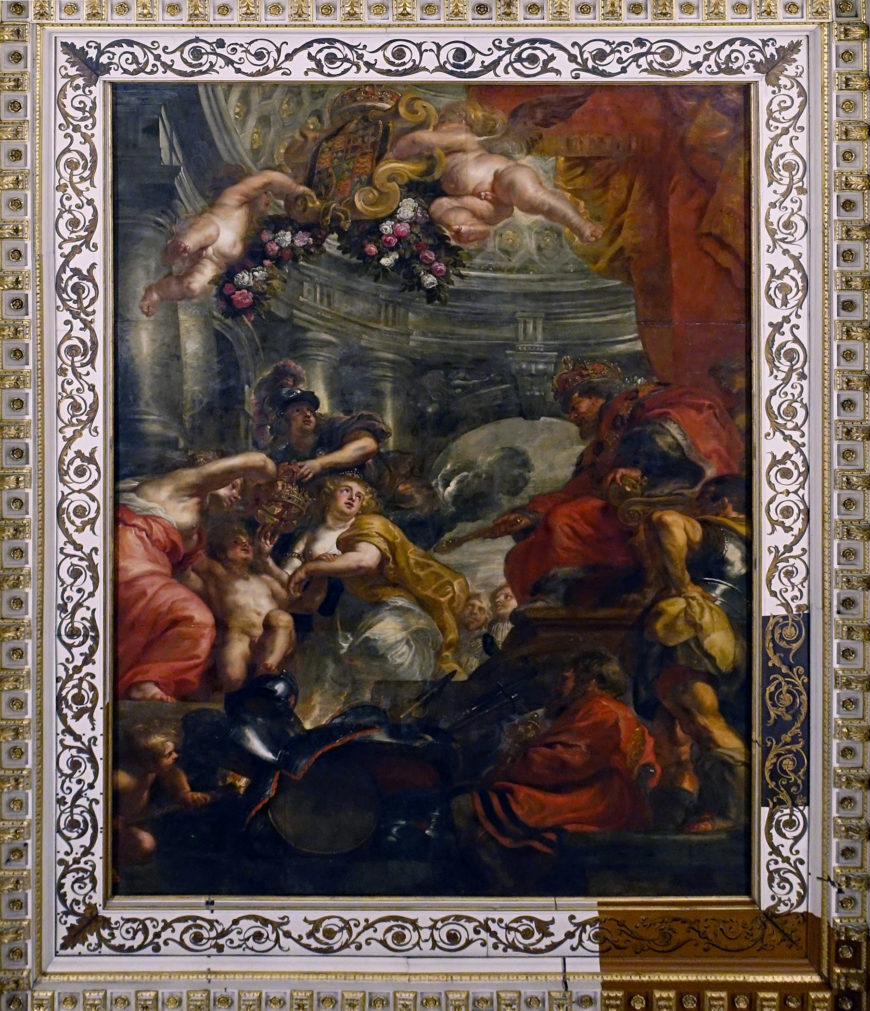
Peter Paul Rubens, The Union of the Crowns of Scotland and England, ceiling of the Banqueting House, Whitehall, c. 1632–34, oil on canvas (photo: Steven Zucker, CC BY-NC-SA 2.0)
The Union of the Crowns of Scotland and England at the north end portrays the union between the crowns of Scotland and England through the accession of James VI of Scotland to the throne of England as King James I. Wearing an imperial crown and attired in parliamentary robes, an enthroned James leans forward, his left hand resting on an orb, while in his right hand he points with his scepter, commanding the goddess Minerva to join the crowns of the two kingdoms held by the personifications of Scotland and England over the head of an infant, who may represent the Prince of Great Britain, the future King Charles I, or possibly Cupid.
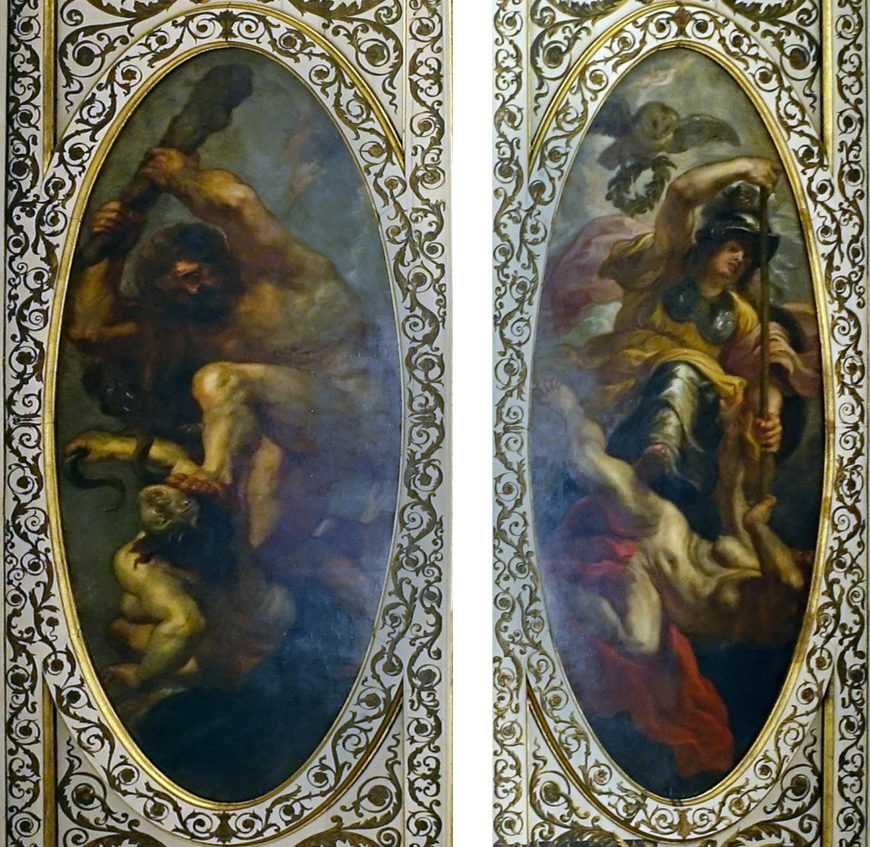
Peter Paul Rubens, oval panels, ceiling of the Banqueting House, Whitehall, c. 1632–34, oil on canvas. Left: Hercules slaying Envy; right: Minerva spearing Ignorance (photos: Steven Zucker, CC BY-NC-SA 2.0)
The oval panels to either side depict the triumph of the Virtues over the Vices: on the left, Hercules (Heroic Virtue) slays Envy (or Rebellion) with a club, while on the right Minerva (or Wisdom) spears Ignorance.
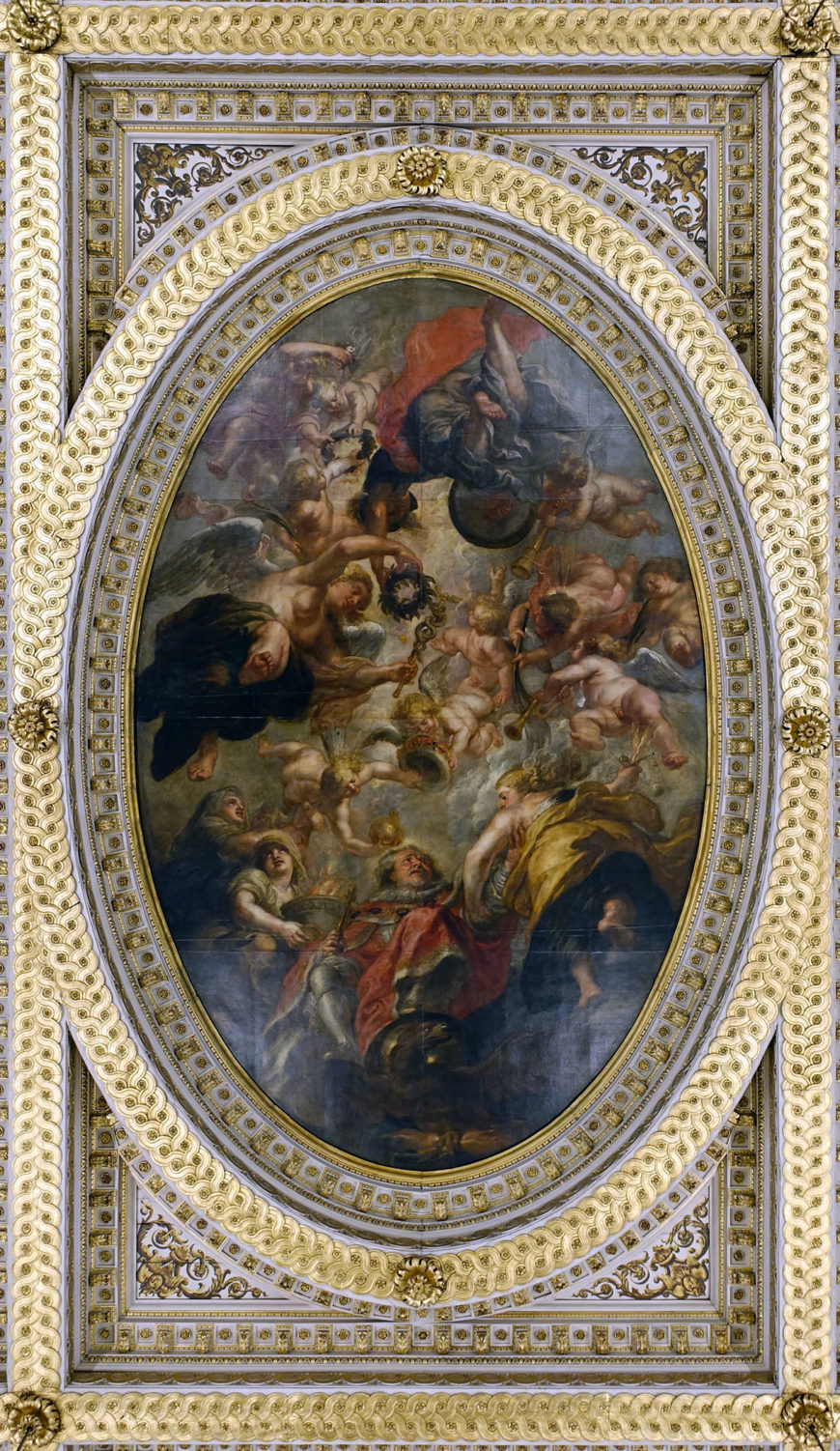
Peter Paul Rubens, The Apotheosis of James I, ceiling of the Banqueting House, Whitehall, c. 1632–34, oil on canvas (photo: Steven Zucker, CC BY-NC-SA 2.0)
The central oval panel of The Apotheosis of James I is a flurry-some swirl of figures in which an airborne James, scepter in his right hand, his left foot resting on an imperial globe, is heralded heavenwards as “King of Great Britain” on the wings of Jupiter’s great eagle, accompanied by the yellow-garbed figure of Justice. To the left are the female figures of Piety or Zeal and Religion, while above the triumphal crown is carried by the goddess Minerva and a figure representing Victory or Peace.
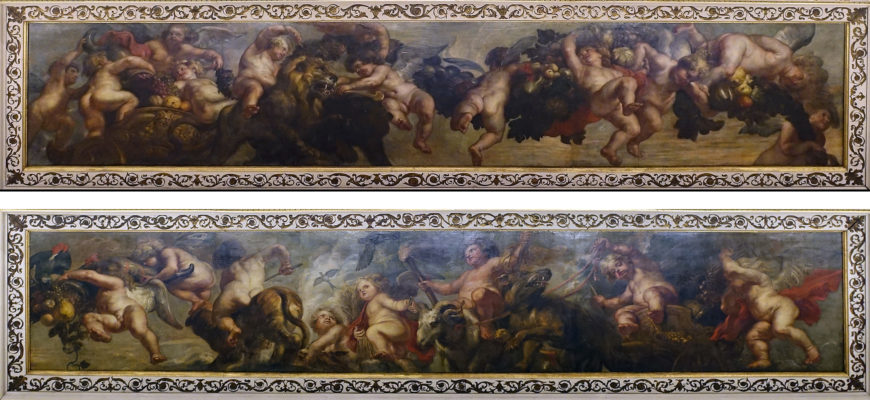
Peter Paul Rubens, rectangular panels, ceiling of the Banqueting House, Whitehall, c. 1632–34, oil on canvas. Top: Genii loading a chariot with fruit; bottom: Genii driving a chariot driven by a ram and a wolf (photos: Steven Zucker, CC BY-NC-SA 2.0)
On either side are long rectangular panels that celebrate the peacefulness and bountifulness of the Jacobean reign: on the left (the west side), frolicking Genii or Putti load a cornucopia of fruit onto a chariot led by a lion and a bear; and on the right (the east side), a procession of Genii or Putti (cherubs) with a fruit-laden chariot driven by a ram and a wolf are depicted.
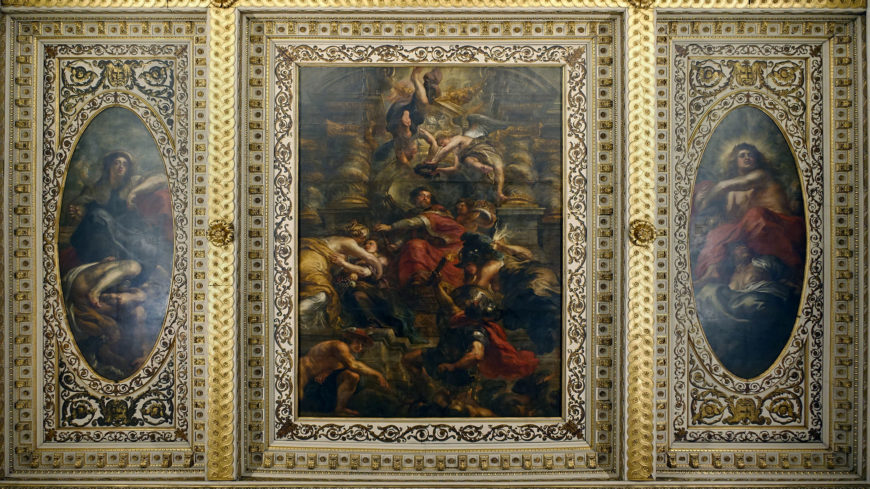
Peter Paul Rubens, The Peaceful Reign of James I, ceiling of the Banqueting House, Whitehall, c. 1632–34, oil on canvas (photo: Steven Zucker, CC BY-NC-SA 2.0)
In The Peaceful Reign of James I at the south end, above the dais where the monarch would sit, James is depicted as a latter-day King Solomon (the king of Israel who is traditionally associated with virtue and wisdom) seated within a biblically-inspired architectural setting of two large Solomonic “barley sugar” columns. James is presented with the laurels of victory by two winged figures descending from the heavens. To the left, the personifications of Peace and Plenty embrace one another, while to the right, Minerva, wearing a helmet and holding a shield and the thunderbolts of Jupiter, puts down the red-caped figure of Mars. In the left foreground, Mercury holds out his caduceus around which two snakes entwine, symbolizing peace.
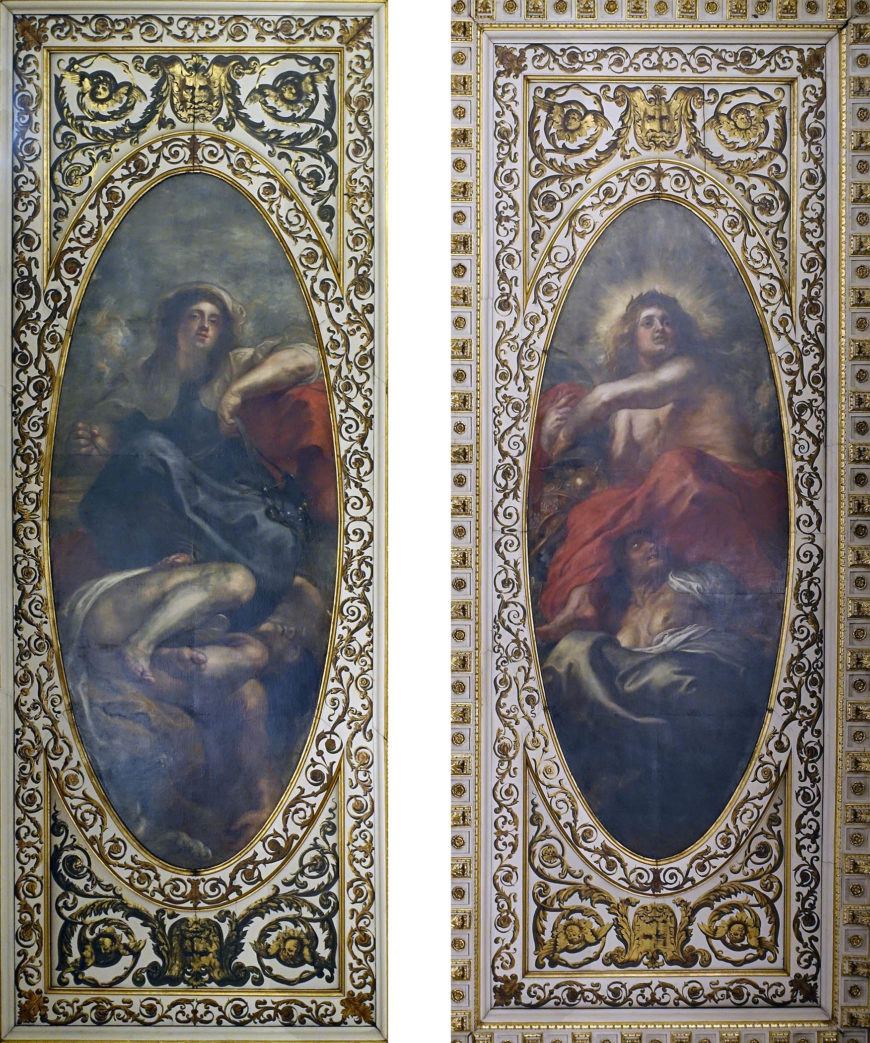
Peter Paul Rubens, oval panels, ceiling of the Banqueting House, Whitehall, c. 1632–34, oil on canvas. Left: Reason bridling Intemperance; right: Abundance triumphing over Avarice. (photos: Steven Zucker, CC BY-NC-SA 2.0)
The oval canvas to the left of this painting portrays Reason (or Wise Government), who bridles Intemperance, while the canvas on the right depicts Abundance (or Royal Bounty), holding a cornucopia, who triumphs over Avarice (Greed).
Spectacle on the scaffold
It is no small dramatic irony that the building presenting James VI of Scotland and James I of England as “God’s lieutenant upon earth” served as the backdrop to the stage for the execution of his son. The spilling of the blood of Charles I significantly stunted the development of the European-influenced court culture that the Jacobean age had done so much to usher in. It would not be until the early eighteenth century that classical architecture would again take hold in Britain.
Additional Resources
The Banqueting House on Historic Royal Palaces
Engraving of Rubens’s ceiling paintings by Simon Gribelin, 1720, on Google Arts and Culture
Engravings of Rubens’s ceiling paintings from the Royal Collection, UK
Christy Anderson, Inigo Jones and the Classical Tradition (Cambridge: Cambridge University Press, 2008).
Colen Campbell, Vitruvius Britannicus: The Classic of Eighteenth-Century British Architecture (London: Dover, 2007 [1715–1725]).
Fiona Donovan, “Rubens, Sir Peter Paul (1577–1640),” Oxford Dictionary of National Biography (Oxford University Press, 2004; online edn.)
Fiona Donovan, Rubens and England (New Haven and London: Yale University Press, 2004).
Vaughn Hart, Inigo Jones: The Architect of Kings (Studies in British Art) (New Haven and London: Yale University Press for the Paul Mellon Centre for Studies in British Art, 2011).
Linda Levy Peck, The Mental World of the Jacobean Court (Cambridge: Cambridge University Press, 2005).
Gregory Martin, “The Banqueting House ceiling: two newly discovered projects,” Apollo, vol. 139 (February 1994), pp. 29–43.
Gregory Martin, The Ceiling Decorations of the Banqueting Hall (Corpus Rubenianum Ludwig Burchard), Part XV, 2 vols (London and Turnhout: Harvey Miller/Brepols Publishers, 2005).
Gregory Martin, Rubens in London: Art and Diplomacy (London and Turnhout: Harvey Miller/Brepols Publishers, 2011).
Oliver Millar, “Rubens’s Whitehall Ceiling,” The Burlington Magazine, vol. 149, no. 1247, Flemish and Dutch Art, (February 2007), pp. 101–104.
Oliver Millar, “The Whitehall Ceiling,” The Burlington Magazine, vol. 98, 1956, pp. 258–257.
John Newman, “Jones, Inigo (1573–1652),” Oxford Dictionary of National Biography (Oxford University Press, 2004; on-line edn).
Pier Palma, Triumph of Peace: A Study of the Whitehall Banqueting House (Stockholm: Almqvist, 1956).
Roy Strong, Britannia Triumphans: Inigo Jones, Rubens and Whitehall Palace (Walter Neurath Memorial Lecture) (London and New York: Thames and Hudson, 1981).
John Summerson, Inigo Jones, with a foreward by Howard Colvin (New Haven and London: Yale University Press for The Paul Mellon Centre for Studies in British Art, 2000).
Simon Thurley, Whitehall Palace: an architectural history of the royal apartments, 1240–1698 (New Haven and London: Yale University Press, 1999).
Jenny Wormald, “James VI and I (1566–1625),” Oxford Dictionary of National Biography (Oxford University Press, 2004; on-line edn.)
Giles Worsley, Inigo Jones and the European Tradition (New Haven and London: Yale University Press for the Paul Mellon Centre for Studies in British Art, 2007).
Smarthistory images for teaching and learning:
[flickr_tags user_id=”82032880@N00″ tags=”BanquetingHse,”]

